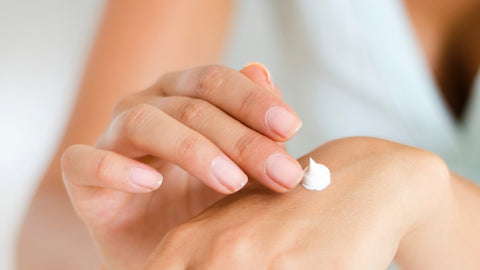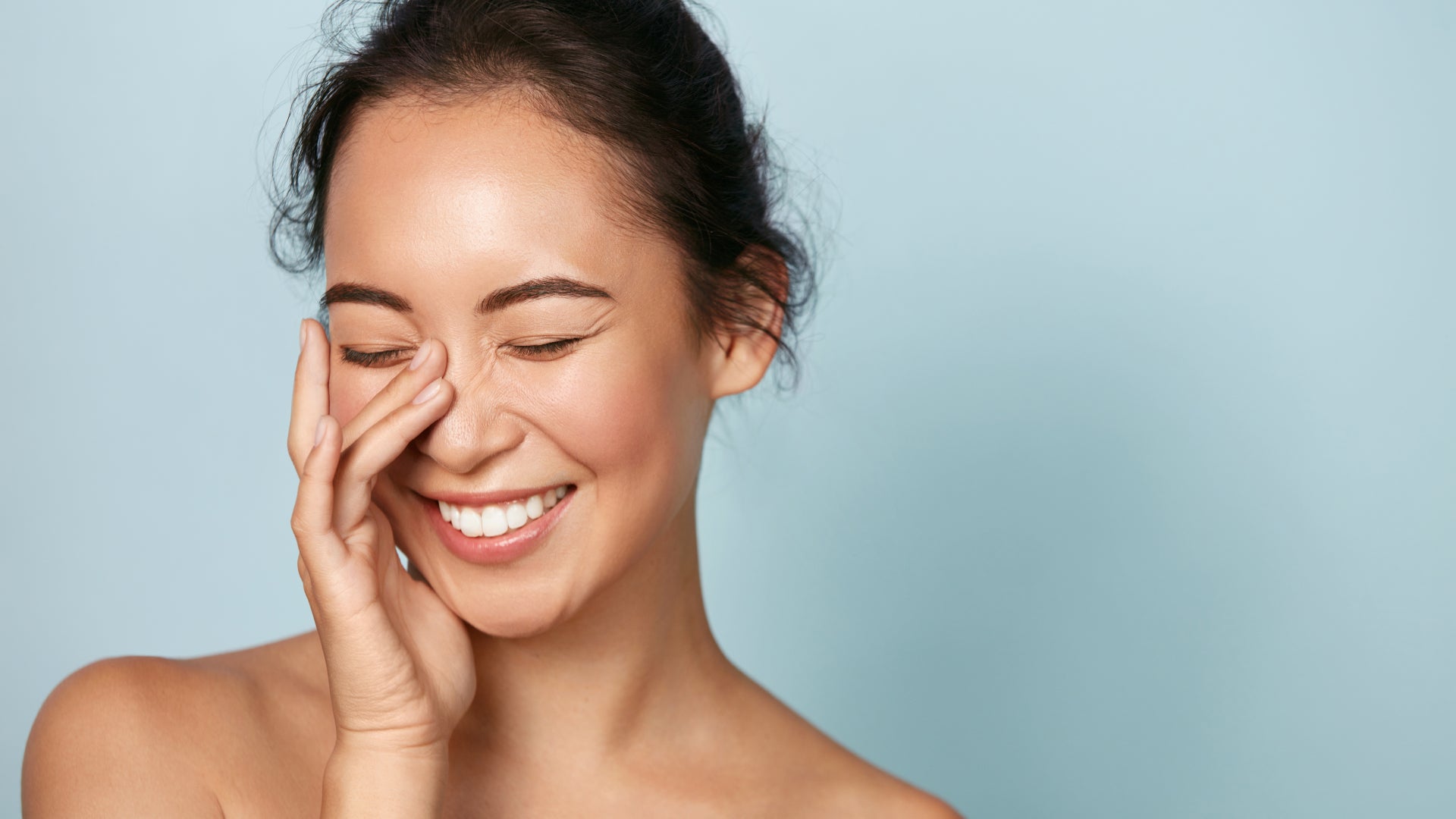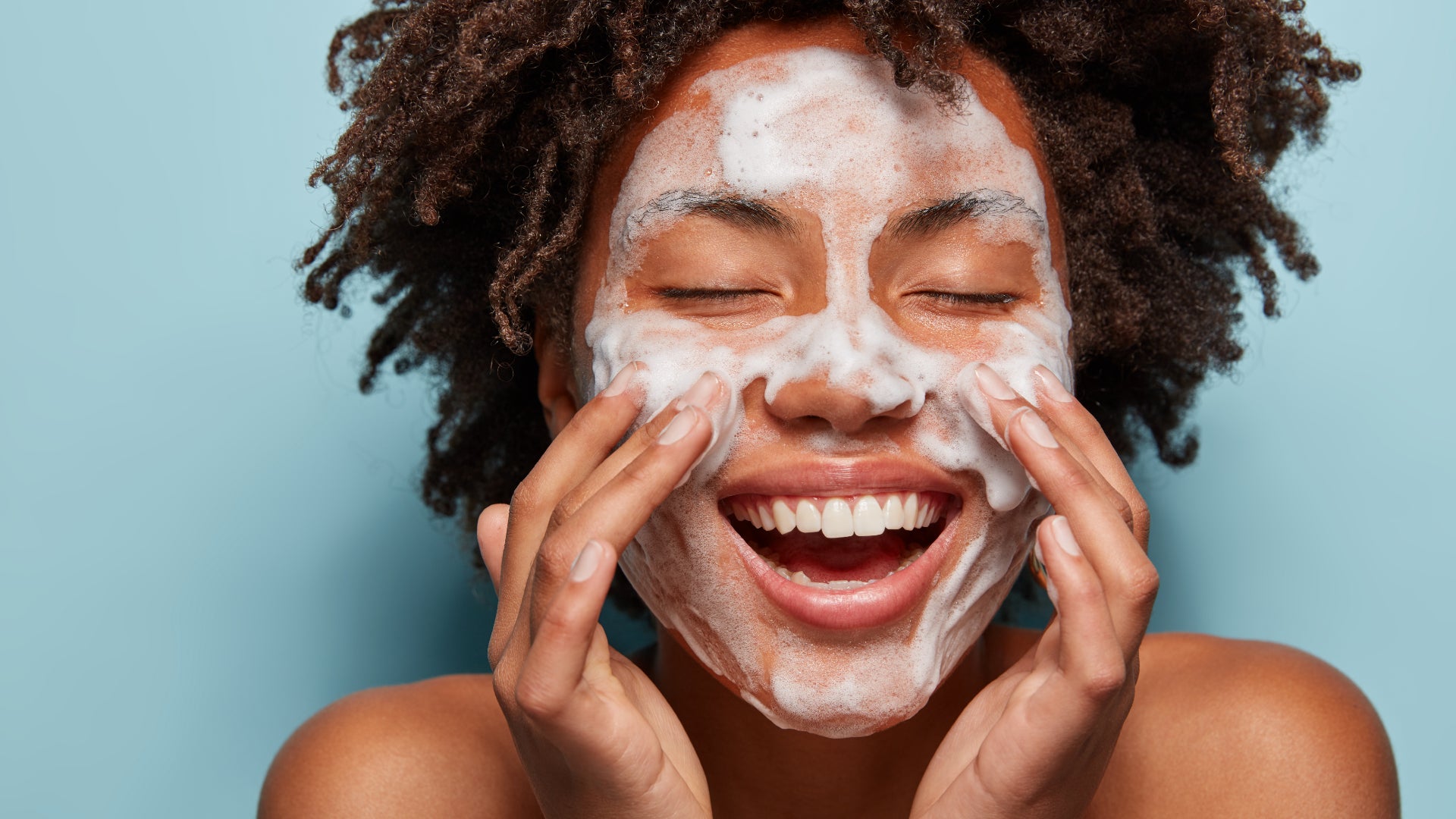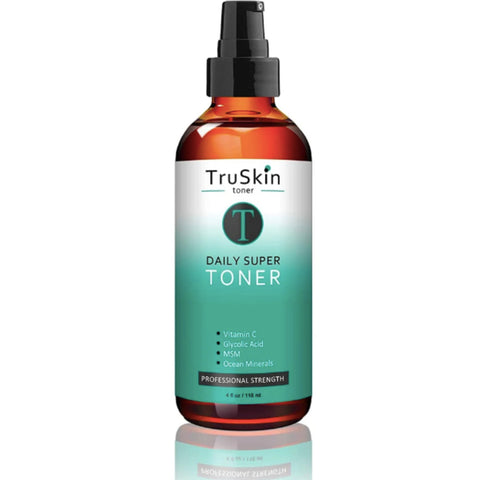
True Radical Honesty From Our Community
What To Do If You Hate Those Fine Lines Around Your Lips
Read MoreAdvice for all of your skin care needs
-
Testing a new beauty product before applying it all over your skin or hair can seem like a real chore. But tell us this: would you ever jump straight into a hot bath without dipping your toe in the water first? No chance. So, why are you on board with patch testing hair color, but not skincare? It’s definitely time to changed that…
We recently read a sad story about a young woman who used an at-home peeling solution for the first time and ended up with terrible blisters all over her chin. She performed what she thought was an adequate test by applying a little of the formulation to her cheek for five minutes. Then, because she felt no adverse reaction, she went for it.
Big mistake. Huge. She paid the price the next day with burning skin that turned into nasty red bumps. The following day, these bumps turned into blisters. The next day they continued to worsen. And for many weeks following.
This made us think, just how important proper patch testing is. And that most consumers know little about it, let alone the reasons why they should be doing it after purchasing any new skincare product.
So, here’s everything you need to know about how and why your skin can react to certain ingredients in skincare – and what you can do to avoid it.
The Truth About What Goes In Your Skincare
When it comes to skincare ingredients, manufacturers like us are very strict about testing everything that goes into our product formulas. We are, after all, responsible for ensuring every product is safe for consumer use when used correctly and according to its directions.
However, the worrying truth is that, other than color additives, cosmetic ingredients do not have to be tested or approved by the FDA (US Food and Drug Administration) before going to market. They’re regulated, yes, and there’s plenty of research and data online about how effective and safe most ingredients are, but the FDA has no authority over any cosmetic product you put on your face and body.
Due to the strength, power and concentration of our active, plant-based formulations, we take this very seriously and thoroughly test everything before including it in our products. But still, you can’t be sure every brand has the same high standards.
Red flag number one.
How Your Own Skin Comes Into Play
Another important thing to remember is that your skin is totally unique to you. So, while the latest influencer, glossy magazine beauty editor or Love Island star might get all the feels from a much-hyped skincare product, who’s to say that your skin will behave in the exact same way?
Similarly, you may think your skin is as strong as steel and can take anything you throw at it: retinol, vitamin C, glycolic acid, the works. Well, this might be true, but whether you have sensitive skin or not, there’s always the possibility of reacting to a certain active ingredient in skincare. And here’s the kicker. People can develop allergies at any time in their lives, so even if you’ve used an ingredient before, it may still cause your skin to flare-up at a later date.
Red flag number two.
So, What Can You Do To Prevent Skin Irritation?
First up it’s vital, we repeat vital to only ever buy products from brands you trust. Once you’ve got this in your head, you can then think in more detail about what your put on your face.
One of the biggest mistakes you could make is to overload your skin with countless products containing strong actives. Word of warning: unless these actives have been carefully combined into one treatment by a reputable manufacturer, or you’ve been prescribed a curated regimen by a board-certified skin expert, this is a bad idea. Instead, introduce active ingredients one at a time, giving yourself a few weeks to acclimate before starting another. You could also try an antioxidant such as vitamin E in the morning, then an AHA or retinol treatment at night to get the benefits of both while keeping them separate and reducing your chances of irritation.
Another trick is to check the labels before you buy a new product and try to avoid some of the most common irritants in skincare such as parabens, formaldehyde and sulfates.
The best way to avoid unwanted flare-ups, however, is to carry out a patch test first.
How To Perform A Patch Test At Home
Patch tests are a piece of cake. All you need to do is apply a small dot of your new product to a discreet patch of clean skin such as behind your ears, inside your elbow, on the side of your neck or on your wrist.
Skin can take up to 48 hours to react to a product or ingredient it doesn’t like, so you should ideally leave the product for at least 24 hours (preferably 48) before checking for a negative reaction. If you see or feel anything that doesn’t look right after this time such as redness, burning, swelling or itching, discontinue use and return it because something’s not right. And should symptoms continue or worsen, seek advice from a board-certified skincare expert.
Any mild reaction such as slight redness or tingling that occurs within the first hour of applying your product is fine – it’s the intention of most active ingredients, especially AHAs and BHAs, to work out the skin. This should settle down within 30-60 minutes, but if it continues or gets worse, rinse your skin immediately.
If you experience no adverse reactions over the 24-48 hour time period, you should be good to apply the product to your skin as instructed. But remember, those directions are there for a reason, so stick with them. To the letter.
What To Do If You Discover A Skin Allergy
If you’re concerned about a serious reaction and think you might have some kind of allergy such as contact dermatitis, make sure to book an appointment with a board-certified dermatologist or allergist. Chances are, you’re allergic to a certain ingredient which can be diagnosed through a more detailed type of patch testing.
Patch testing at the doctor’s office is a whole different ball game and involves having a number of small patches of allergens applied to the skin and observed for adverse reactions. During this test, your skin may be exposed to up to 30 different substances at once, so it’s a great way to eliminate certain chemicals and ingredients from both your skincare and household products.
Remember, knowledge is a powerful thing and can be a lifesaver for your skin.
Why Patch Testing Skincare Is Everything
read more -
Start off your skincare routine with mediocre cleansing and you may as well haul the rest of your serums, moisturizers and sunscreen off to the trash. Dramatic? Maybe. But when it comes to cleansing your skin, we truly believe that only the best techniques and products will do.
The problem, however, is that while most of you know how important clean skin is to its look, feel and overall health, you’re not that bothered about how you get it clean. Right?
Take those devils called facial wipes, for example. As the third most wasteful product in the world, wipes are terrible for the environment – most are non-biodegradable and take up to 100 years to break down in landfill – and they’re not much better for your skin. While handy for camping, at festivals or when you need a quick freshen up before or after the gym, they often come brimming with chemicals, fragrance and preservatives. These nasties get smeared all over your face and neck, which alters the skin’s pH balance and goes on to cause various unwanted problems including excessive dryness, clogged pores, redness and irritation. Bad news all round, especially if you have sensitive skin.
We say avoid wipes at all costs. Instead, spend a little more time over your cleansing routine (don’t worry, a couple of minutes is all it takes) and your skin will really thank you for it. As will the world we live in. Win-win.
Here’s how.
First, Choose The Best Cleanser For Your Skin Type
Our number one rule for choosing the best cleanser – no matter what your skin type or concerns are – is to go as gentle as possible. Contrary to popular belief, gentle doesn’t mean ineffective, just that it won’t damage the skin’s natural protective layer, suck up every last inch of sebum or upset your skin's pH balance. And even if your skin is super-oily, this is a good thing.
Here are a few other pointers, according to your skin type.
Dry SkinLook for soothing cleansers that contain humectants like panthenol, glycerin or hyaluronic acid. These all work to pull moisture from the air into the surface of the skin which helps reduce dryness and irritation.
Normal Or Combination Skin
Sensitive Skin
Gentle formulations that help balance as you cleanse are perfect for normal or combination skin types as they help promote a healthy, all-over glow. You could also try upping your free radical fighting powers with a cleanser that contains antioxidants such as vitamins C and E.Steer well clear of sulfates, parabens and alcohol as these will do nothing but exacerbate sensitivities and irritation. One of our favorite ingredients for sensitive skin is rose water, a great cleanser that helps heal, soothe and hydrate.
Oily Or Acne-Prone SkinIf you suffer with excess oil, glycolic acid is an excellent ingredient as it works as a mild, follicular cleansing aid to stimulate collagen, boost cell renewal and tighten pores. We also love coconut charcoal for its unique ability to draw out impurities and balance the skin.
Next, Learn How To Cleanse Like A Pro
Spend time massaging your skin for a couple of minutes as you wash your face and you'll instantly boost circulation and help lymphatic drainage.
It’s really quite simple. Apply cleanser all over your face and neck, then use the pads of your fingers to work it into your skin. First, press your fingers into the brow area and slide them up to your forehead a few times. Next, concentrate on your cheeks, working from each side of your nose, out towards the hairline. Do this a few times, then continue with the same motion at around chin level. To finish, smooth your fingertips up your neck. Oh, and if you have specific areas of congestion around your nose, chin or forehead, don’t forget to give these a little extra attention, using light circular motions to massage as you cleanse.
One last thing: the skin around your eyes is thin and very delicate so don’t get too handsy with your massaging technique when it comes to the eye area. Instead, use soft rolling movements with your ring finger around the orbital bones and if you like to wear eye makeup on a daily basis, invest in a good eye makeup remover to avoid tugging and pulling the skin as you cleanse.
Finally, Try A Night-Time Double Cleanse
Like to sneak off to bed every now and again, without cleansing your skin? Well, you can stop that, right now. Just think about what your skin is subjected to throughout the day... Environmental pollutants, grime, oil and sweat all sit on your skin for the 15 hours or so while you’re awake. Then, when you throw makeup into the mix, which is often full of man-made chemicals, you’ve created a whole cocktail of ‘stuff’ lurking on your complexion, just waiting to cause problems.
This is why a thorough, pre-bedtime cleanse to remove all the dirt and debris that’s built up throughout the day is so important. As you sleep, your skin goes into full recharge mode, regenerating new skin cells and repairing environmental damage, but how can it do this efficiently when it’s dirty? Answer: it can’t. Instead, it’ll punish you with poor, rough texture; dull, dry skin; bags under your eyes, the works.
So, for a super-effective, but gentle night-time clean up job, try double cleansing.
Double cleansing can take on many forms but basically means cleaning your skin twice, using two different methods. Start with an oil-based cleanser, gentle exfoliator or cloth to remove makeup, sunscreen and other surface debris. Then go for a cream, gel or lotion to finish cleansing and treating your skin according to your skin type or concerns.
And now you’re ready for the next phases of your skincare routine: namely toning, treating, moisturizing and protecting.
Now, that wasn't too painful, was it?
How To Cleanse Your Skin Like A Pro
read more -
For many years, the only serum to be concerned about was the stuff you’d put on your hair in a bid to ward off humidity-induced frizz. Then serums started to creep into skincare and bam, suddenly you couldn’t move for those potent little jars of antioxidant-packed, hydration-promoting or acne-preventing face serums.
Nowadays, ask any dermatologist for their top five recommendations for healthy, ageless skin and some kind of serum will be right up there. The problem is, skin serums create all manner of bewilderment for us mere mortals. They can be moisturizing, but should never be confused with moisturizers. They can also help protect your skin from UV damage, yet they’re definitely not sunscreens either.
Mind. Officially. Blown.
So, what’s the definition of a face serum and why are they integral to the look and feel of your skin? Herein, the ten things you need to know about these small but perfectly formed skincare treatments.
1. First things first, what is a face serum? Simply put, it’s a light, fast-absorbing product that’s usually clear and either gel- or liquid-based. Serum is applied after cleansing and toning, but before moisturizing and, depending on the type of serum you choose, is used to help hydrate, protect and/or treat various skin concerns. Think of it as a small but super-powerful boost to your normal routine.
2. Without sounding too much like a lesson from 8th grade chemistry, the boosting powers of a face serum comes from its molecular make up. Serums, you see, are made up of much smaller molecules than regular lotions or creams. This means your skin is able to absorb whatever ingredients they contain quicker and deeper than other, thicker products.
3. Does this mean serums are better than moisturizers? Well, yes and no. While the molecular, water-based structure of serums allows them to be packed with a higher concentration of nutrients and active ingredients – often including humectants such as hyaluronic acid – what serums don’t contain are the thicker, heavier moisturizing ingredients known as occlusives.
Occlusives such as shea butter, petrolatum, coconut oil and squalane are the base of many moisturizers because they form a kind of barrier over the skin to help prevent transepidermal water loss. And this, dear friends, is why serum and moisturizer work so well as a team. First, your serum delivers the active ingredients deep into your skin to target any particular concerns you may have, then your moisturizer locks all those ingredients in. Clockwork.
4. Speaking of skin concerns, serums come in all guises to help treat everything from pigmentation issues through to acne, fine lines, excess sebum and poor texture. But they’re not for everyone. If you have any kind of chronic skin condition, such as eczema, psoriasis or rosacea, tread carefully. These conditions all work to weaken the skin’s natural protective barrier which means that serums may be too potent and could cause you further irritation and sensitivities.
5. Sensitive skin types should also be careful of diving head first into a vat of potent serums because of their high dosage of active ingredients like retinol, vitamin C and other antioxidants. While these ingredients are usually well tolerated by most skin types, if you’re sensitive and worried a new treatment serum might cause flare-ups, try applying it on alternate days to begin with. You can then up your usage if and when your skin acclimates.
6. There are many ingredients to choose from that have been tried, tested and clinically-proven to target and visibly improve various skin concerns. We’re not going to keep you here for hours going through a long list of them all, but here are a few we firmly believe in.
Glycolic Acid: an alpha hydroxy acid (AHA) that’s great for brightening and gently exfoliating.
Hyaluronic Acid: the hydrating genius, perfect for all skin types.
Niacinamide: a water-soluble form of vitamin B3 that helps strengthen sensitive skin.
Retinol: a derm favorite and the ideal overnight anti-aging treatment.
Salicylic Acid: a pore-unclogging beta hydroxy acid (BHA) that helps dissolve dead skin cells and calm breakouts.
Vitamin C: a potent antioxidant that helps reduce pigmentation and brighten dull skin.7. You may be a whizz when it comes to creating kick-ass Friday night cocktails, but skincare cocktailing is much more of a fine art. Reckon your skin will be perfectly OK if you overload it with acids, vitamins and other active ingredients? Well, the truth is, it might not, so either stick with one in the morning and one at night, or leave it to the professionals (er, hello!) to formulate the perfect blend of advanced, all-in-one serums.
8. When it comes to applying your serum like a true pro, the rules are simple. Smooth it on your skin after cleansing and toning, but before moisturizing, and remember, a little goes a long way. Most products give a guideline as to how much you should use, but serums are super-potent, so one or two drops is usually enough.
To really a pack a punch, you could also try applying serum while your skin is still slightly damp after cleansing and toning. This will vamp up penetration even more. Word of warning, though, if you have sensitive skin, ensure your skin is totally dry and wait 10 minutes between cleansing and applying serum. After serum, wait another few minutes before applying moisturizer, followed by a broad-spectrum sunscreen in the morning.
9. Small, visible benefits from a serum can often be seen in a matter of days, but just because serums are packed with potent ingredients, this doesn’t mean they’re miracle-workers. For the best results, always give your product six or seven weeks to do its best work.
10. As with most skincare products, not all serums are created equal, so it’s always smart to read the labels and educate yourselves on the best ingredients as well as their ideal concentrations. And remember, just because a serum costs $200, this doesn’t mean it’s necessarily better than one that’s a tenth of the price. Most of that $200 is going towards advertising, fancy packaging and celebrity endorsements, so just because the latest it-girl is worth it, this doesn’t guarantee the serum is. Just saying.
Why Face Serums Are The Key To A Winning Skincare Routine
read more -
Photo by Andrea Piacquadio from Pexels
Cleanser, moisturizer and sunscreen are a given in anyone’s skincare routine, but when it comes to toner, opinions are split. So, what’s the truth? Can toner really benefit your skin? Actually, yes, it can. And it does.
Underrated and misunderstood, toner has endured a lot of bad press over the years. How so? Well, for the most part it's been due to those high-alcohol toners from decades ago that were celebrated for their astringent nature and ‘big gun’ approach to removing every last scrap of oil, makeup and indeed life from the face.
We know most of you (us included, tbh) loved that kind of modus operandi during your hormonal teenage years, but the fact is, those sebum-strippers were totally counter-productive for the skin (spots and dry patches, anyone?). Furthermore, ‘squeaky clean’ skin has been way off the agenda since 1990 for everyone over the age of 35. Hence, it’s been a not-so-fond farewell to toner ever since.
Honestly, we think this is unfair to the hard-working toners of the world since many of them provide so much more than the beloved Sea Breezes of yesteryear. In fact, the right formulation can offer all manner of post-cleansing benefits including brightening, anti-aging, firming and clarifying.
So, could a toner be the exact treatment you’ve been looking for in your skincare routine?
Let’s see how toner can work for your own skin type, shall we?
Oily Or Blemish-Prone Skin
Sadly, some over-the-counter toners specifically formulated for oily skin are the worse things you could put on your face. Why? Because they often contain irritants which, granted, may dry out your skin in the short-term, but in the long-term work to stimulate oil production, making your skin even oilier... yet somehow kind of dry at the same time. Frustrating is not the word.
To help stabilize your sebum levels, choose a balancing toner that contains AHAs or BHAs such as salicylic or glycolic acids. These are super effective for thoroughly cleansing the skin, while unclogging pores and helping to prevent breakouts.
Dry/Dehydrated Skin
This may sound like a contradiction in terms, but treatment toners are a very effective way to hydrate and nourish the skin. It’s all about the ingredients that go into the toner – as well as the ones that have been left out, of course.
If you suffer with dryness or dehydration, look for added ingredients like glycerin, aloe vera or hyaluronic acid and try to go alcohol-free.
"If you have dry or sensitive skin, the one ingredient to avoid in your toner is alcohol. Alcohol is irritating and further dries out the skin," warns board-certified New York City dermatologist, Dr. Lance H. Brown.
Alcohols like isopropyl alcohol, methanol, propanol and alcohol denat are often used as preservatives in skincare, and while many skin types tolerate them perfectly well, they can cause unwanted problems for others, including irritation, inflammation and breakouts.
Super Sensitive Skin
Gentle and fragrance-free are the only way to go if you have sensitive skin. Sensitivities can be caused by all sorts of ingredients in skincare, so the less you pile on your skin, the better.
One of our favorite ingredients for sensitive skin is rose water which dates back to ancient Egypt where it was applied to the skin for its powerful antibacterial, antioxidant and anti-redness properties. Rose water is a great cleanser and simultaneously helps heal, balance, hydrate and strengthen the skin. It can also be used to control excess sebum and works hard to soothe the symptoms of acne, eczema and dermatitis. Is there anything this baby can’t do for the skin? Well, rose water can’t reverse time and completely eradicate your wrinkles, but other than that it’s pretty darn amazing. Just ensure you only ever buy 100 percent pure rose water – added nasties will only cause unwanted flare-ups.
Dull Or Mature Skin
Good news, people: toner can also improve the next step in your skincare routine which is great news for anyone interested in combating dullness, fine lines, pigmentation or other visible signs of aging. This may sound like the stuff of dreams, but bear with us while we explain.
It’s a well-known fact that moist skin absorbs product more effectively than dry skin. This is why you’re often advised to apply moisturizer to slightly damp, cleansed skin. Well, the same applies to freshly toned skin. The added moisture gives your skincare the perfect base, allowing it to penetrate the skin faster and more effectively. Simple science.
"To help naturally exfoliate mature skin, look for toners that contain additional ingredients such as alpha-hydroxy acids, salicylic acids and retinols," explains Dr. Lance H. Brown.
"Antioxidants like vitamin C are also an effective way to contribute to the overall health of your skin," he adds.
Good news: we've got you covered right there, with our Daily Super Toner. You're welcome.
The Toner Debate: Does Your Skin REALLY Need It?
read more -
Photo by Anna Shvets from Pexels
We’re totally on board with upping your skincare game, but it’s rarely as simple as buying the latest Instagram beauty hit and hoping for the best. It takes time, patience and a little side of know-how. Here are our golden rules for getting it right, every time.
Rule #1: Understand Your Skin
You may think you know your skin type, but when was the last time you took a few moments to study and feel your skin? Three months ago? Last year? Well, let us ask you this: does your skin act, look and feel the same as it did a couple of months ago? Probably not.
All manner of external and internal factors change the way your skin behaves. Yes, it might be a little shiny and oily during the summer, but then it could feel dry and tight in the winter. Similarly, that super lightweight lotion might have been perfectly adequate for moisturizing your skin in your teens, but now you’re older, chances are your skin needs much more help in the hydration department.
So, what’s the solution? The best way to know what your skin is doing right now is to cleanse it, leave it totally free of product for a couple of hours, then look at it in the mirror and feel it – with clean hands, of course. If it already looks shiny and feels greasy, you probably have oily skin, whereas if there are patches of dryness or flakiness, it’s erring towards being dry and/or dehydrated. Maybe it’s a mixture of the two: then you have combination skin. And if it feels absolutely perfect, then lucky you, you have normal skin. Simple.
Next, study areas of concern such as around the eyes or along your cheekbones. Do you see lines that weren’t there last time you checked? Dark circles around your eyes? Or maybe there’s a little pigmentation across your cheeks? All this detective work will help you pinpoint not only your skin type, but the areas you want to address with your skincare routine.
Rule #2: Always Do A Patch Test
Skincare ingredients don't have to be tested or approved by the FDA (US Food and Drug Administration) so, while there’s plenty of research and data on how effective and safe most products and their ingredients are, it’s always sensible to test out anything new before putting it all over your face. Yes, we know that desperate feeling of wanting to immediately slather your face in your spanking new Vitamin C serum, but do a patch test, wait just 24 hours and your skin will thank you for it.
Patch tests are very simple. All you need to do is apply a little of the product to a discreet patch of your skin (behind your ears, inside your elbow, on the side of your neck, even on your hand), then leave it for 24 hours to check for a reaction. Nothing? Then you should be good to apply it to your face. If, however, you experience any kind of redness, swelling, itching or irritation, something in that product clearly doesn’t agree with your skin, so you should return it and either try something else, or go back to a product you know works.

Photo by Linda Prebreza from Pexels
If you know your skin is consistently super sensitive and reactive to any new brand or product, please be extra careful when trying something new. In fact, your best bet is to book an appointment with a board-certified dermatologist before switching up your skincare routine. Chances are, you’re allergic to a certain ingredient which a skin specialist can diagnose, then you can avoid.
Rule #3: Slowly Does It
The primary goal of a great skincare routine is to consistently improve and maintain a healthy complexion. So, while it might be tempting to go nuts with retinols, AHAs and antioxidant serums all at once, this is really not wise if your skin is not used to such active ingredients. In fact, it’s the opposite of wise – especially if you have sensitive skin.
A better idea is to start your skin off with one new product at a time, giving yourself one or two weeks before introducing another. Then, if you have any kind of negative reaction, you’ll be able to pinpoint the exact product that caused it.
Rule #4: Learn How To Layer
Nailed the right balance of products but not sure in which order to apply them? After cleansing and toning, the general rule of thumb is to apply the thinnest product first and the thickest, most dense product (usually sunscreen or night cream) last. This means your serum (maybe it’s an antioxidant, perhaps it’s an acne treatment) comes after toning, followed by your moisturizer to seal in all the goodness. If you like to apply a face oil for extra hydration or radiance, this can be applied after moisturizer because oil has the ability to penetrate cream, but not the other way round. And if your moisturizer doesn't contain sunscreen? Apply this as your final step. Most sunscreen sits on your skin rather than penetrating the top layers, so if you put this on before anything else it'll act like a barrier and prevent your products from doing their jobs. That’s what we call money down the drain.
Another thing to remember is not to rush as you layer your products. Slap them on too quickly and you’ll run the risk of pilling. Instead, apply your serum, then stick the coffee on or brush your teeth before moving on to moisturizer and finally sunscreen.
Rule #5: Remember, Breakouts Aren’t Always Bad
Granted, breakouts are often a response to something in your skincare routine. Over-rich moisturizer containing mineral oils, petroleum and petrolatum for example, can suffocate your pores, increase sebum production and exacerbate pimples, so avoid these if you’re prone to acne.
Also, if you clash certain ingredients in your beauty regimen – hydroquinone and benzoyl peroxide, for example, are a notoriously bad combo – your skin will not thank you for it. We know this can be confusing, so try readily prepared combinations from trusted skincare brands or stick with one main, active ingredient in your morning regimen and another one in the evening.
But as the title of this section notes, breakouts are not always a bad thing.
Say hello to the skin purge...
Skin purging is when your skin reacts to certain active ingredients like retinol, AHAs and BHAs which work to accelerate the exfoliation process, thus promoting cell turnover. While these ingredients sound great in practice – and they are in the long run – they can temporarily bring blockages to the surface, causing redness, irritation and unwanted pimples.
Our best advice for avoiding these annoying flare-ups? First, slowly introduce active ingredients into your routine (see #3 above) to allow your skin to adjust – even if this means using a certain product just once or twice a week to begin with. You can always up your usage as your skin becomes more tolerant.
Also, be patient as your skin adapts to new, powerful ingredients – pimples, blackheads and bumps due to skin purging are temporary and should soon pass. If they don’t go away within a few weeks, however, or if they get worse, always visit a board-certified dermatologist or skin expert for advice.
How To Build A New Skincare Routine
read more













